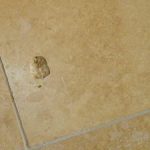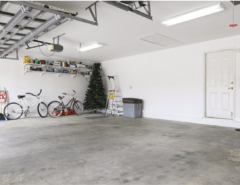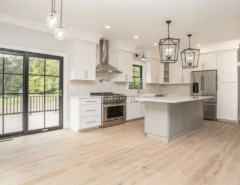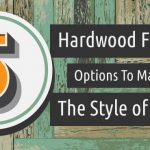
When you hear the word vinyl, you might think of the bygone era of vinyl records. However, vinyl is growing in popularity as a flooring choice. More homeowners are turning to this cousin of linoleum because of its advantages over other types of flooring. With a range of options available, you might have questions when you start shopping for vinyl flooring. Make sure you know the answers to these important questions, so you can choose the right vinyl flooring for your home.
How Is Vinyl Flooring Made?
Vinyl flooring is a synthetic product made of plastic. The top layer is called the wear layer, and it’s one of the key parts of the floor. Vinyl flooring has three types of wear layers, and it’s important to keep in mind where you want to install your vinyl when you’re considering which wear layer to get.
The first wear layer is a vinyl no-wax finish. It’s the lightest wear layer, so it’s good for areas that won’t get much moisture, dirt, or foot traffic. The next type of wear layer is the urethane finish. This type is more durable, so it can stand up to moderate foot traffic. The final type of wear layer is the enhanced urethane finish. It’s the toughest finish available, and it’s highly resistant to scratches and stains and can stand up to heavy foot traffic.
After the wear layer is the decorative or printed layer that gives the vinyl its color and design. Next you have a foam layer, and finally, you reach the backing of the vinyl flooring. Although you never see the backing, it’s still a very important part of the flooring, as it increases the vinyl flooring’s resistance to mildew and moisture. Additionally, the thicker the backing, the higher the quality of the vinyl flooring.
What Formats Can I Get?
Long gone are the days when you could only find vinyl flooring in long sheets. While sheet formats are still available, you can also get vinyl in tiles and planks. Vinyl sheets usually are sold in rolls that come in 6- to 12-foot wide panels. The main advantage of a vinyl sheet is that it offers a smooth and seamless look. This is ideal for rooms that get a lot of moisture, such as a bathroom.
Vinyl tiles are smaller than sheets. This format usually comes in 12- or 18-inch squares, which are meant to mimic the size of a ceramic or porcelain tile. The majority of vinyl tiles come with a self-adhesive back, which makes them easy to install and replace. Finally, just like vinyl tiles mimic the look of stone tiles, vinyl planks are created to look like hardwood planks. Your average vinyl plank will measure 4 to 6 inches wide and 3 to 4 feet in length.
How Durable Is Vinyl Flooring?
Vinyl flooring is known for its durability. If you choose a flooring option with a thick wear layer, it’s nearly impossible to dent. Additionally, it’s very resistant to stains, rips, and scuffs. Since vinyl flooring is made entirely of plastic, it also offers superior resistance to moisture. In fact, you can submerge a piece of vinyl underwater for days and see no harmful effects to it.
Where Can I Install Vinyl Flooring?
The beauty of vinyl flooring is that you can install it in nearly every room of the house. Since vinyl flooring is so durable, it’s perfect for areas of the home that receive a lot of foot traffic, such as an entryway. Additionally, because vinyl flooring is water-resistant, it’s ideal for rooms that see plenty of moisture, like a bathroom, laundry room, basement, or kitchen. If you like the look of tile, but you want a softer flooring option in the rooms you spend a lot of time in, such as the bedroom or living room, vinyl flooring is a great choice.
However, it’s important to keep in mind that while vinyl flooring can hold up to a significant amount of wear and tear, sharp objects and extreme temperatures can damage the flooring. Additionally, too much exposure to direct sunlight can make the colors in vinyl flooring fade over time. This is why manufacturers don’t recommend vinyl flooring for outdoor or indoor/outdoor use.
How Much Does It Cost?
Another advantage that vinyl flooring has over other types of flooring is that it has a variety of inexpensive options. While prices will vary depending on the thickness of the wear layer, you can usually find vinyl flooring that’s between $2 and $12 per square foot. Additionally, several manufacturers create a product called luxury vinyl tile, or LVT, which closely mimics the look of natural materials, such as stone or wood. Since LVT offers a thicker wear layer and an impressively realistic look, it’s slightly more expensive than traditional vinyl flooring and averages $3 to $14 per square foot.
Can I Repair or Replace It?
Even though vinyl flooring is durable, it’s not completely indestructible. If you have a sheet of vinyl with damage, you can either attempt to patch the damaged area using a leftover piece of scrap flooring, or you can replace the entire sheet. Fortunately, if you have planks or tiles, it’s easier to replace any damaged pieces. You simply need to remove the piece that’s damaged and lay down a leftover plank or tile.
How Do I Clean Vinyl Flooring?
Maintaining and cleaning a vinyl floor is very easy. Regular sweeping and an occasional damp mop to wipe up dirt are all you need to keep vinyl floors clean. Even though vinyl is water-resistant, liquid can get between the panels and weaken the adhesive or cause mold. Therefore, you should avoid using a soaking wet mop and be sure to wipe up any spills as quickly as possible.
If you think vinyl flooring might be the perfect option for your home, keep these important questions in mind when you’re shopping, to make sure you select the style that best suits your needs.
Resources:























